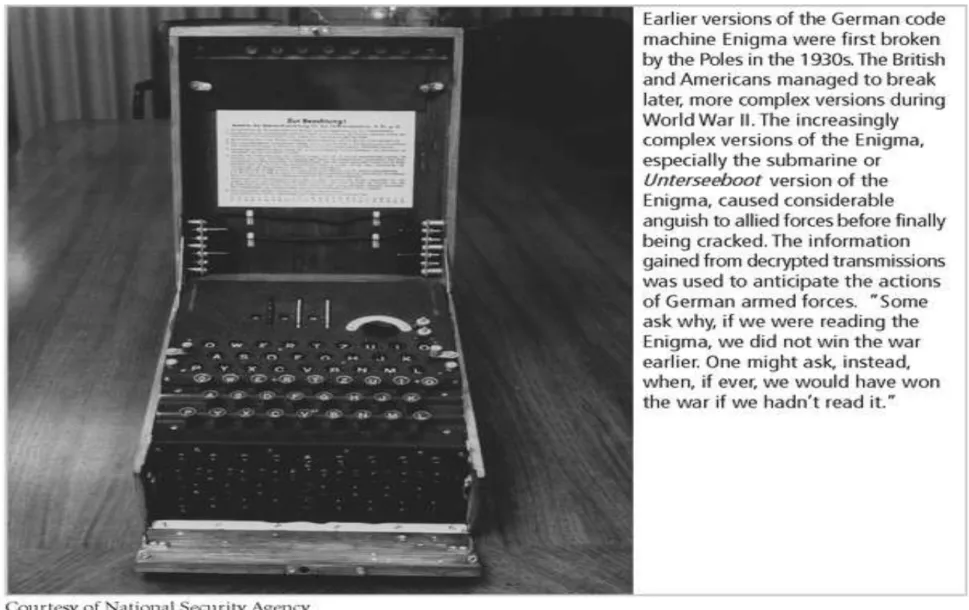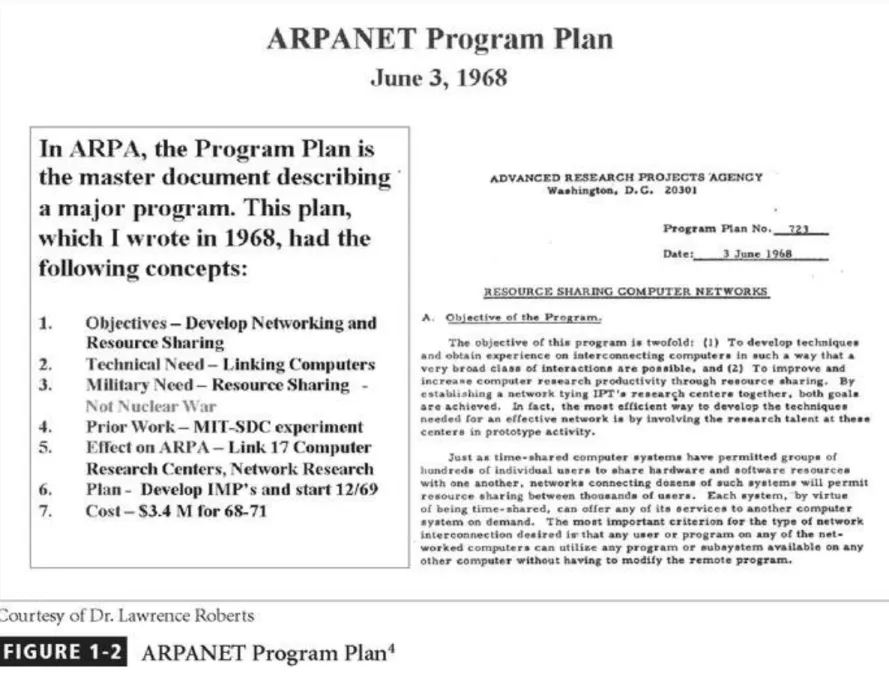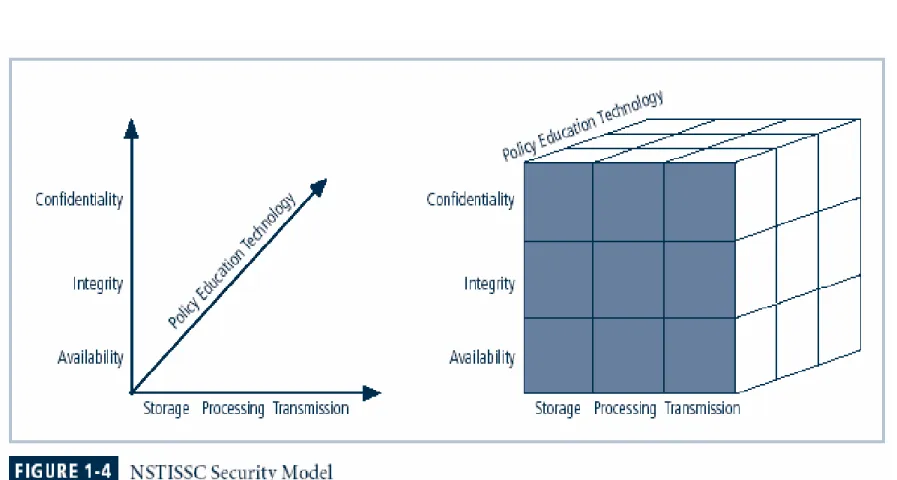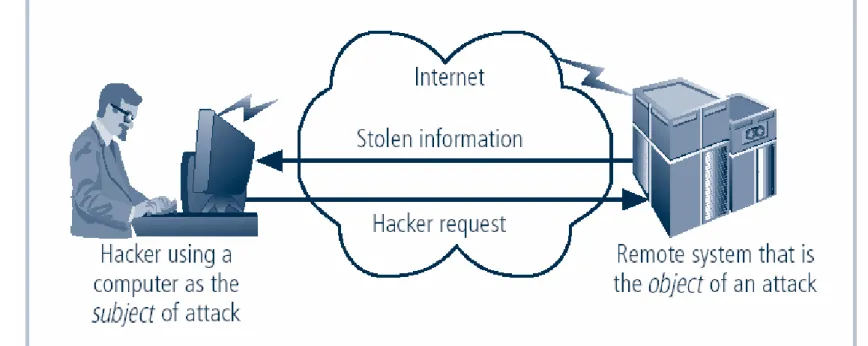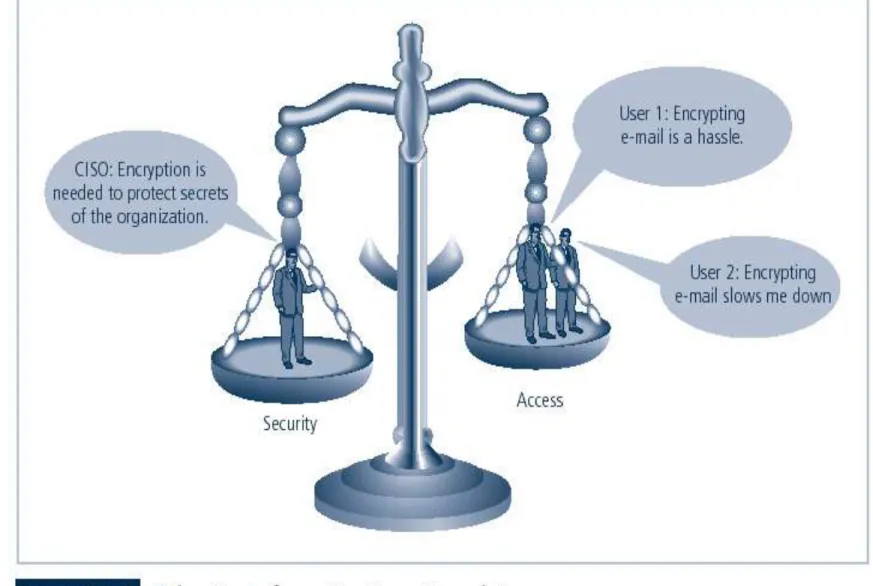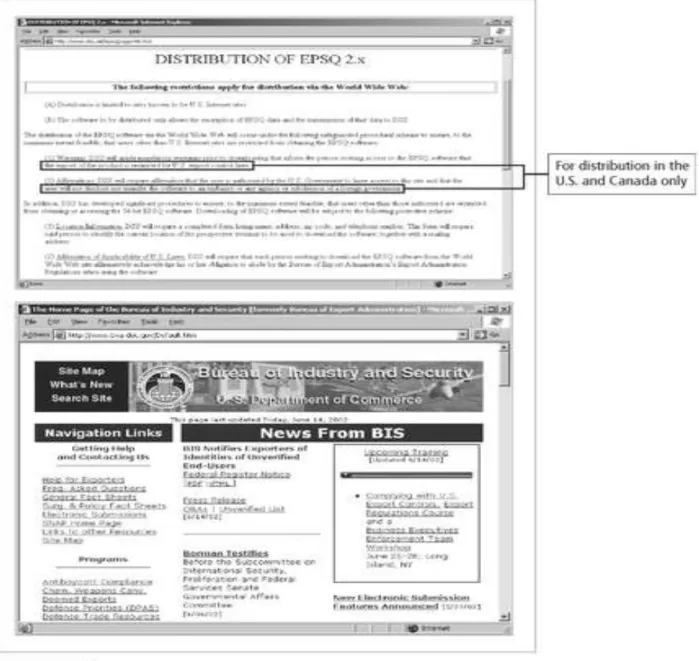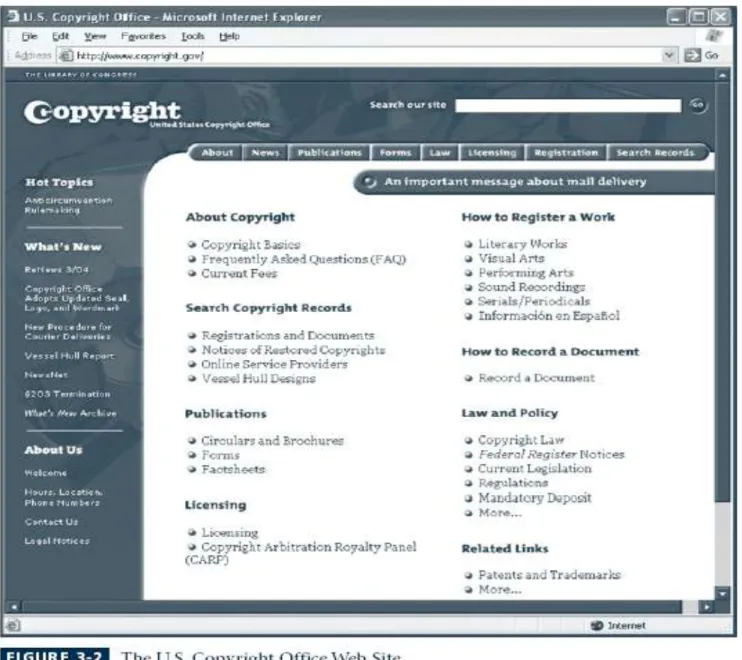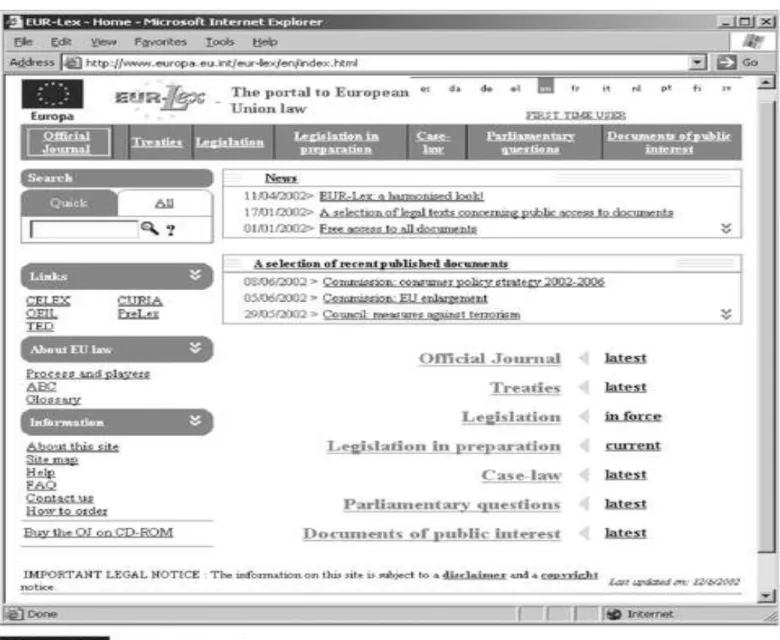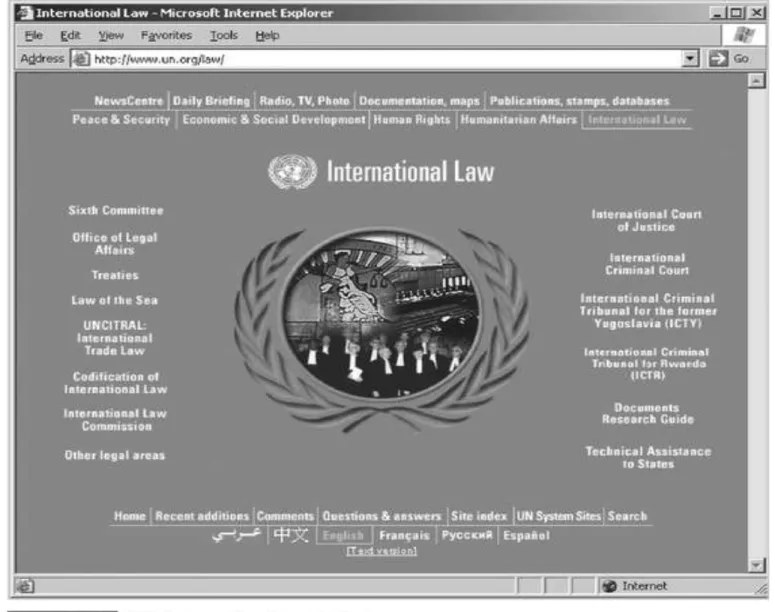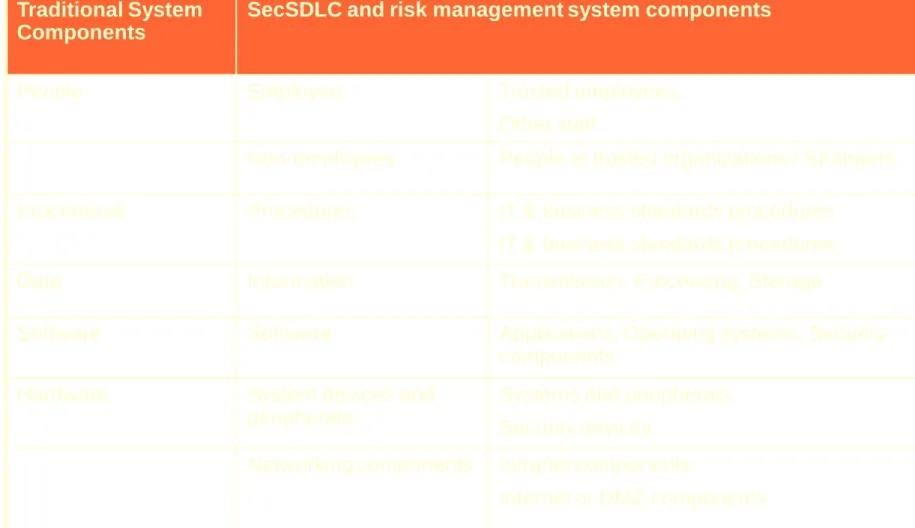Principles of Information Security, 2nd Edition 2
Understand the definition of information security
Comprehend the history of computer security and how it evolved into information security
Understand the key terms and critical concepts of information security as presented in the chapter
Outline the phases of the security systems development life cycle
Understand the roles of professionals involved in information security within an organization
Learning Objectives
Upon completion of this material, you should be able to:
Principles of Information Security, 2nd Edition 3
Introduction
Information security: a ―well-informed sense of
assurance that the information risks and controls are in balance.‖ —Jim Anderson, Inovant (2002)
Necessary to review the origins of this field and its impact on our understanding of information security today
Principles of Information Security, 2nd Edition 4
The History of Information Security
Began immediately after the first mainframes were developed
Created to aid code-breaking computations during World War II
Physical controls to limit access to sensitive military locations to authorized personnel: badges, keys, and facial recognition
Rudimentary in defending against physical theft, espionage, and sabotage
Principles of Information Security, 2nd Edition 5
Figure 1-1 – The Enigma
Principles of Information Security, 2nd Edition 6
The History of Information Security
One of 1st documented problems
Early 1960s
Not physical
Accidental file switch
Entire password file
printed on every output file
Principles of Information Security, 2nd Edition 7
The 1960s
Additional mainframes online
Advanced Research Procurement Agency (ARPA) began to examine feasibility of redundant networked communications
Larry Roberts developed ARPANET from its inception
ARPANET is the first Internet
Principles of Information Security, 2nd Edition 8
Figure 1-2 - ARPANET
Principles of Information Security, 2nd Edition 9
The 1970s and 80s
ARPANET grew in popularity as did its potential for misuse
Fundamental problems with ARPANET security were identified
No safety procedures for dial-up connections to ARPANET
Non-existent user identification and authorization to system
Principles of Information Security, 2nd Edition 10
R-609
Information security began with Rand Report R-609 (paper that started the study of computer security)
Scope of computer security grew from physical security to include:
Safety of data
Limiting unauthorized access to data
Involvement of personnel from multiple levels of an organization
First identified role of management and policy
Principles of Information Security, 2nd Edition 11
The History of Information Security
Multics
Operating System
Security primary goal
Didn’t go very far
Several developers created Unix
Late 1970s: microprocessor expanded computing capabilities and security threats
From mainframe to PC
Decentralized computing
Need for sharing resources increased
Major changed computing
Principles of Information Security, 2nd Edition 12
The 1990s
Networks of computers became more common; so too did the need to interconnect networks
Internet became first manifestation of a global network of networks
In early Internet deployments, security was treated as a low priority
Many of the problems that plague e-mail on the Internet are the result to this early lack of security
Principles of Information Security, 2nd Edition 13
The Present
The Internet brings millions of computer networks into communication with each other—many of them
unsecured
Ability to secure a computer’s data influenced by the security of every computer to which it is connected
Principles of Information Security, 2nd Edition 14
What is Security?
―The quality or state of being secure—to be free from danger‖
A successful organization should have multiple layers of security in place:
Physical security
Personal security
Operations security
Communications security
Network security
Information security
Principles of Information Security, 2nd Edition 15
What is Information Security?
The protection of information and its critical elements, including systems and hardware that use, store, and transmit that information
Necessary tools: policy, awareness, training, education, technology
C.I.A. triangle was standard based on confidentiality, integrity, and availability
C.I.A. triangle now expanded into list of critical characteristics of information
Principles of Information Security, 2nd Edition 16
Principles of Information Security, 2nd Edition 17
Critical Characteristics of Information
The value of information comes from the characteristics it possesses:
Timeliness
No value if it is too late
Availability
No interference or obstruction
Required format
Accuracy
Free from mistakes
Authenticity
Quality or state of being genuine, i.e., sender of an email
Confidentiality
Disclosure or exposure to unauthorized individuals or system is prevented
Principles of Information Security, 2nd Edition 18
Critical Characteristics of Information
Integrity
Whole, completed, uncorrupted
Cornerstone
Size of the file, hash values, error-correcting codes, retransmission
Utility
Having value for some purpose
Possession
Ownership
Breach of confidentiality results in the breach of possession, not the reverse
Principles of Information Security, 2nd Edition 19
Figure 1-4 – NSTISSC Security Model
NSTISSC Security Model
Principles of Information Security, 2nd Edition 20
Components of an Information System
Information System (IS) is entire set of software, hardware, data, people, procedures, and networks necessary to use information as a resource in the organization
Software
Perhaps most difficult to secure
Easy target
Exploitation substantial portion of attacks on information
Hardware
Physical security policies
Securing physical location important
Laptops
Flash memory
Principles of Information Security, 2nd Edition 21
Components of an Information System
Data
Often most valuable asset
Main target of intentional attacks
People
Weakest link
Social engineering
Must be well trained and informed
Procedures
Threat to integrity of data
Networks
Locks and keys won’t work
Principles of Information Security, 2nd Edition 22
Securing Components
Computer can be subject of an attack and/or the object of an attack
When the subject of an attack, computer is used as an active tool to conduct attack
When the object of an attack, computer is the entity being attacked
2 types of attack
Direct
Hacker uses their computer to break into a system
Indirect
System is compromised and used to attack other systems
Principles of Information Security, 2nd Edition 23
Figure 1-5 – Subject and Object of
Attack
Principles of Information Security, 2nd Edition 24
Balancing Information Security and Access
Impossible to obtain perfect security—it is a process, not an absolute
Security should be considered balance between protection and availability
To achieve balance, level of security must allow reasonable access, yet protect against threats
Principles of Information Security, 2nd Edition 25
Figure 1-6 – Balancing Security and
Access
Principles of Information Security, 2nd Edition 26
Approaches to Information Security Implementation: Bottom-Up Approach
Grassroots effort: systems administrators attempt to improve security of their systems
Key advantage: technical expertise of individual administrators
Seldom works, as it lacks a number of critical features:
Participant support
Organizational staying power
Principles of Information Security, 2nd Edition 27
Principles of Information Security, 2nd Edition 28
Approaches to Information Security Implementation: Top-Down Approach
Initiated by upper management
Issue policy, procedures and processes
Dictate goals and expected outcomes of project
Determine accountability for each required action
The most successful also involve formal development strategy referred to as systems development life cycle
Principles of Information Security, 2nd Edition 29
The Systems Development Life Cycle
Systems development life cycle (SDLC) is methodology
and design for implementation of information security within an organization
Methodology is formal approach to problem-solving based on structured sequence of procedures
Using a methodology
ensures a rigorous process
avoids missing steps
Goal is creating a comprehensive security posture/program
Traditional SDLC consists of six general phases
Principles of Information Security, 2nd Edition 30
Principles of Information Security, 2nd Edition 31
The Security Systems Development Life Cycle
The same phases used in traditional SDLC may be
adapted to support specialized implementation of an IS project
Identification of specific threats and creating controls to counter them
SecSDLC is a coherent program rather than a series of random, seemingly unconnected actions
Principles of Information Security, 2nd Edition 32
The Security Systems Development Life Cycle
Investigation
Identifies process, outcomes, goals, and constraints of the project
Begins with enterprise information security policy
Analysis
Existing security policies, legal issues,
Perform risk analysis
Principles of Information Security, 2nd Edition 33
The Security Systems Development Life Cycle
Logical Design
Creates and develops blueprints for information security
Incident response actions: Continuity planning, Incident response, Disaster recovery
Feasibility analysis to determine whether project should continue or be outsourced
Physical Design
Needed security technology is evaluated, alternatives generated, and final design selected
Principles of Information Security, 2nd Edition 34
The Security Systems Development Life Cycle
Implementation
Security solutions are acquired, tested, implemented, and tested again
Personnel issues evaluated; specific training and education programs conducted
Entire tested package is presented to management for final approval
Maintenance and Change
Most important
Constant changing threats
Constant monitoring, testing updating and implementing change
Principles of Information Security, 2nd Edition 35
Security Professionals and the Organization
Wide range of professionals required to support a diverse information security program
Senior management is key component; also, additional administrative support and technical expertise required to implement details of IS program
Principles of Information Security, 2nd Edition 36
Senior Management
Chief Information Officer (CIO)
Senior technology officer
Primarily responsible for advising senior executives on strategic planning
Chief Information Security Officer (CISO)
Primarily responsible for assessment, management, and implementation of IS in the organization
Usually reports directly to the CIO
Principles of Information Security, 2nd Edition 37
Information Security Project Team
A number of individuals who are experienced in one or more facets of technical and non-technical areas:
Champion: Senior executive who promotes the project
Team leader: project manager, departmental level manager
Security policy developers
Risk assessment specialists
Security professionals
Systems administrators
End users
Principles of Information Security, 2nd Edition 38
Data Ownership
Data Owner: responsible for the security and use of a particular set of information
Data Custodian: responsible for storage, maintenance, and protection of information
Data Users: end users who work with information to perform their daily jobs supporting the mission of the organization
Principles of Information Security, 2nd Edition 39
Communities Of Interest
Group of individuals united by similar interest/values in an organization
Information Security Management and Professionals
Information Technology Management and Professionals
Organizational Management and Professionals
Principles of Information Security, 2nd Edition 40
Key Terms
Access
Asset
Attack
Control, Safeguard or Countermeasure
Exploit
Exposure
Hacking
Object
Risk
Security Blueprint
Security Model
Security Posture or Security Profile
Subject
Threats
Threat Agent
Vulnerability
Principles of Information Security, 2nd Edition 41
Critical infrastructure
From Wikipedia.
Critical infrastructure is a term used by governments to describe systems or material assets that are essential for the functioning of a society and economy. Most commonly associated with the term are facilities for:
electricity generation and distribution;
telecommunication;
water supply;
agriculture, food production and distribution;
heating(natural gas, fuel oil);
public health;
transportation systems (fuel supply, railway network, airports);
financial services;
security services (police, military).
Critical-infrastructure protection is the study, design and implementation of precautionary measures aimed to reduce the risk that critical infrastructure fails as the result of war, disaster, civil unrest, vandalism, or sabotage.
Principles of Information Security, 2nd Edition 42
Summary
Information security is a ―well-informed sense of
assurance that the information risks and controls are in balance.‖
Computer security began immediately after first mainframes were developed
Successful organizations have multiple layers of security in place: physical, personal, operations, communications, network, and information.
Principles of Information Security, 2nd Edition 43
Summary
Security should be considered a balance between protection and availability
Information security must be managed similar to any major system implemented in an organization using a methodology like SecSDLC
Implementation of information security often described as a combination of art and science
Our bad neighbor makes us early stirrers, Which is both healthful and good husbandry.
-- William Shakespeare (1564–1616), King Henry, in Henry V, act 4, sc. 1, l. 6-7.
The Need For Security
Pri nci ple s of Inf or ma tio n Se cur ity - Ch apt er 2 45
Learning Objectives
Upon completion of this lecture, you should be able to:
Understand the need for information security.
Understand a successful information security program is the responsibility of an organization’s general
management and IT management.
Understand the threats posed to information security and the more common attacks associated with those threats.
Differentiate threats to information systems from attacks against information systems.
Pri nci ple s of Inf or ma tio n Se cur ity - Ch apt er 2 46
Business Needs First, Technology Needs Last
Information security performs four important functions for an organization:
Protects the organization’s ability to function
Enables the safe operation of applications
implemented on the organization’s IT systems
Protects the data the organization collects and uses
Safeguards the technology assets in use at the organization
Pri nci ple s of Inf or ma tio n Se cur ity - Ch apt er 2 47
Protecting the Ability to Function
Management is responsible
Information security is
a management issue
a people issue
Communities of interest must argue for information security in terms of impact and cost
Pri nci ple s of Inf or ma tio n Se cur ity - Ch apt er 2 48
Enabling Safe Operation
Organizations must create integrated, efficient, and capable applications
Organization need environments that safeguard applications
Management must not abdicate to the IT
department its responsibility to make choices and enforce decisions
Pri nci ple s of Inf or ma tio n Se cur ity - Ch apt er 2 49
Protecting Data
One of the most valuable assets is data
Without data, an organization loses its record of transactions and/or its ability to deliver value to its customers
An effective information security program is
essential to the protection of the integrity and value of the organization’s data
Pri nci ple s of Inf or ma tio n Se cur ity - Ch apt er 2 50
Safeguarding Technology Assets
Organizations must have secure infrastructure services based on the size and scope of the enterprise
Additional security services may have to be provided
More robust solutions may be needed to replace security programs the organization has outgrown
Pri nci ple s of Inf or ma tio n Se cur ity - Ch apt er 2 51
Hands-On Exercise ( 10 Minutes)
You are a security officer working for a medium-sized research company. You have been assigned to guard the facility. Two incidents occur. The first, a well-known manager walks out with a box of papers. The second, someone believed to be an outsider assesses the company information and goes away with the
company blue prints for the next generation product.
1. Briefly list all security gaps, vulnerabilities, threats, risks, and exploits.
2. Describe how these incidents can be overcome.
Pri nci ple s of Inf or ma tio n Se cur ity - Ch apt er 2 52
Threats
Management must be informed of the various kinds of threats facing the organization
A threat is an object, person, or other entity that represents a constant danger to an asset
By examining each threat
category in turn, management effectively protects its information through policy, education and training, and technology controls
Pri nci ple s of Inf or ma tio n Se cur ity - Ch apt er 2 53
Threats
The 2002 CSI/FBI survey found:
90% of organizations responding detected computer security breaches within the last year
80% lost money to computer breaches, totaling over $455,848,000 up from
$377,828,700 reported in 2001
The number of attacks that came across the Internet rose from 70% in 2001 to 74% in 2002
Only 34% of organizations reported their attacks to law enforcement
Pri nci ple s of Inf or ma tio n Se cur ity - Ch apt er 2 54
Threats to Information Security
Pri nci ple s of Inf or ma tio n Se cur ity - Ch apt er 2 55
Acts of Human Error or Failure
Includes acts done without malicious intent
Caused by:
Inexperience
Improper training
Incorrect assumptions
Other circumstances
Employees are greatest threats to information security – They are closest to the organizational data
Pri nci ple s of Inf or ma tio n Se cur ity - Ch apt er 2 56
Acts of Human Error or Failure
Employee mistakes can easily lead to the following:
revelation of classified data
entry of erroneous data
accidental deletion or modification of data
storage of data in unprotected areas
failure to protect information
Many of these threats can be prevented with controls
Pri nci ple s of Inf or ma tio n Se cur ity - Ch apt er 2 57
Pri nci ple s of Inf or ma tio n Se cur ity - Ch apt er 2 58
Deviations in Quality of Service by Service Providers
Situations of product or services not delivered as expected
Information system depends on many inter-dependent support systems
Three sets of service issues that dramatically affect the availability of information and systems are
Internet service
Communications
Power irregularities
Pri nci ple s of Inf or ma tio n Se cur ity - Ch apt er 2 59
Internet Service Issues
Loss of Internet service can lead to considerable loss in the availability of information
organizations have sales staff and telecommuters working at remote locations
When an organization outsources its web servers, the outsourcer assumes responsibility for
All Internet Services
The hardware and operating system software used to operate the web site
Pri nci ple s of Inf or ma tio n Se cur ity - Ch apt er 2 60
Communications and Other Services
Other utility services have potential impact
Among these are
telephone
water & wastewater
trash pickup
cable television
natural or propane gas
custodial services
The threat of loss of services can lead to inability to function properly
Pri nci ple s of Inf or ma tio n Se cur ity - Ch apt er 2 61
Power Irregularities
Voltage levels can increase, decrease, or cease:
spike – momentary increase
surge – prolonged increase
sag – momentary low voltage
brownout – prolonged drop
fault – momentary loss of power
blackout – prolonged loss
Electronic equipment is susceptible to fluctuations, controls can be applied to manage power quality
Pri nci ple s of Inf or ma tio n Se cur ity - Ch apt er 2 62
Espionage/Trespass
Broad category of activities that breach confidentiality
Unauthorized accessing of information
Competitive intelligence vs. espionage
Shoulder surfing can occur any place a person is accessing confidential information
Controls implemented to mark the
boundaries of an organization’s virtual territory giving notice to trespassers that they are encroaching on the
organization’s cyberspace
Hackers uses skill, guile, or fraud to steal the property of someone else
Pri nci ple s of Inf or ma tio n Se cur ity - Ch apt er 2 63
Pri nci ple s of Inf or ma tio n Se cur ity - Ch apt er 2 64
Pri nci ple s of Inf or ma tio n Se cur ity - Ch apt er 2 65
Espionage/Trespass
Generally two skill levels among hackers:
Expert hacker
develops software scripts and codes exploits
usually a master of many skills
will often create attack software and share with others
Script kiddies
hackers of limited skill
use expert-written software to exploit a system
do not usually fully understand the systems they hack
Other terms for system rule breakers:
Cracker - an individual who ―cracks‖ or removes protection designed to prevent unauthorized duplication
Phreaker - hacks the public telephone network
Pri nci ple s of Inf or ma tio n Se cur ity - Ch apt er 2 66
Information Extortion
Information extortion is an attacker or formerly trusted insider stealing information from a computer system and demanding compensation for its return or non-use
Extortion found in credit card number theft
Pri nci ple s of Inf or ma tio n Se cur ity - Ch apt er 2 67
Sabotage or Vandalism
Individual or group who want to deliberately sabotage the operations of a computer
system or business, or perform acts of vandalism to either destroy an asset or damage the image of the organization
These threats can range from petty vandalism to organized sabotage
Organizations rely on image so Web defacing can lead to dropping consumer confidence and sales
Rising threat of hacktivist or cyber-activist operations – the most extreme version is cyber-terrorism
Pri nci ple s of Inf or ma tio n Se cur ity - Ch apt er 2 68
Deliberate Acts of Theft
Illegal taking of another’s property - physical, electronic, or intellectual
The value of information suffers when it is copied and taken away without the owner’s knowledge
Physical theft can be controlled - a wide variety of measures used from locked doors to guards or alarm systems
Electronic theft is a more complex problem to manage and control - organizations may not even know it has occurred
Pri nci ple s of Inf or ma tio n Se cur ity - Ch apt er 2 69
Deliberate Software Attacks
When an individual or group designs software to attack systems, they create malicious
code/software called malware
Designed to damage, destroy, or deny service to the target systems
Includes:
macro virus
boot virus
worms
Trojan horses
logic bombs
back door or trap door
denial-of-service attacks
polymorphic
hoaxes
W O R M W O R
M
Trojan Trojan Horse Horse
BombBomb
Virus Virus
Pri nci ple s of Inf or ma tio n Se cur ity - Ch apt er 2 70
Deliberate Software Attacks
Virus is a computer program that attaches itself to an executable file or application.
It can replicate itself, usually through an executable program attached to an e-mail.
The keyword is ―attaches‖. A virus can not stand on its own.
You must prevent viruses from being installed on computers in your organizations.
Pri nci ple s of Inf or ma tio n Se cur ity - Ch apt er 2 71
Deliberate Software Attacks
Learn about OS and application vulnerabilities.
The Mitre Corporation’s Common Vulnerabilities and Exposures. www.cve.mitre.org
Pri nci ple s of Inf or ma tio n Se cur ity - Ch apt er 2 72
Deliberate Software Attacks
There is no foolproof method of preventing them from attaching themselves to your computer
Antivirus software compares virus signature files against the programming code of know viruses.
Regularly update virus signature files is crucial.
Pri nci ple s of Inf or ma tio n Se cur ity - Ch apt er 2 73
Deliberate Software Attacks
A worm is a computer program that replicates and propagates itself without having to attach itself to a host.
Most infamous worms are Code Red and Nimda.
Cost businesses millions of dollars in damage as a result of lost productivity
Computer downtime and the time spent recovering lost data, reinstalling programming's, operating
systems, and hiring or contracting IT personnel.
Pri nci ple s of Inf or ma tio n Se cur ity - Ch apt er 2 74
Deliberate Software Attacks
Trojan Programs disguise themselves as useful computer programs or applications and can install a backdoor or rootkit on a computer.
Backdoors or rootkits are computer programs that give attackers a means of regaining access to the attacked computer later.
Pri nci ple s of Inf or ma tio n Se cur ity - Ch apt er 2 75
Pri nci ple s of Inf or ma tio n Se cur ity - Ch apt er 2 76
Deliberate Software Attacks
Challenges:
Trojan programs that use common ports, such as TCP 80, or UPD 53, are more difficult to detect.
Many software firewalls can recognize port-scanning program or information leaving a questionable port.
However, they prompt user to allow or disallow, and users are not aware.
Educate your network users.
Many Trajan programs use standard ports to conduct their exploits.
Pri nci ple s of Inf or ma tio n Se cur ity - Ch apt er 2 77
Deliberate Software Attacks
Spyware
A Spyware program sends info from the infected computer to the person who initiated the spyware program on your computer
Spyware program can register each keystroke entered.
www.spywareguide.com
Adware
Main purpose is to determine a user’s purchasing habits so that Web browsers can display advertisements tailored to that user.
Slow down the computer it’s running on.
Adware sometimes displays a banner that notifies the user of its presence
Both programs can be installed without the user being aware of their presence
Pri nci ple s of Inf or ma tio n Se cur ity - Ch apt er 2 78
Protecting against Deliberate Software Attacks
Educating Your Users
Many U.S. government organizations make security awareness programs mandatory, and many private-sector companies are following their example.
Email monthly security updates to all employees.
Update virus signature files as soon as possible.
Protect a network by implementing a firewall.
Avoiding Fear Tactics
Your approach to users or potential customers should be promoting awareness rather than instilling fear.
When training users, be sure to build on the knowledge they already have.
Pri nci ple s of Inf or ma tio n Se cur ity - Ch apt er 2 79
Compromises to Intellectual Property
Intellectual property is ―the ownership of ideas and control over the tangible or virtual representation of those ideas‖
Many organizations are in business to create intellectual property
trade secrets
copyrights
trademarks
patents
Pri nci ple s of Inf or ma tio n Se cur ity - Ch apt er 2 80
Compromises to Intellectual Property
Most common IP breaches involve software piracy
Watchdog organizations investigate:
Software & Information Industry Association (SIIA)
Business Software Alliance (BSA)
Enforcement of copyright has been attempted with technical security mechanisms
Pri nci ple s of Inf or ma tio n Se cur ity - Ch apt er 2 81
Forces of Nature
Forces of nature, force majeure, or acts of God are dangerous
because they are unexpected and can occur with very little warning
Can disrupt not only the lives of individuals, but also the storage, transmission, and use of information
Include fire, flood, earthquake, and lightning as well as volcanic eruption and insect infestation
Since it is not possible to avoid many of these threats, management must implement controls to limit damage and also prepare
contingency plans for continued operations
Snowstorms Snowstorms Hurricanes
Hurricanes Volcanoes Volcanoes Tornadoes Tornadoes Thunderstorms Thunderstorms Earthquakes Earthquakes
Snowstorms Snowstorms Hurricanes
Hurricanes Volcanoes Volcanoes Tornadoes Tornadoes Thunderstorms Thunderstorms Earthquakes Earthquakes
Fire Fire Landslides Landslides
Avalanche Avalanche Humidity Humidity
Windstorms Windstorms Floods Floods
Fire Fire Landslides Landslides
Avalanche Avalanche Humidity Humidity
Windstorms Windstorms Floods Floods
Pri nci ple s of Inf or ma tio n Se cur ity - Ch apt er 2 82
Technical Hardware Failures or Errors
Technical hardware failures or errors occur when a manufacturer distributes to users equipment containing flaws
These defects can cause the system to perform outside of expected parameters, resulting in unreliable service or lack of availability
Some errors are terminal, in that they result in the unrecoverable loss of the equipment
Some errors are intermittent, in that they only periodically manifest themselves, resulting in faults that are not easily repeated
Pri nci ple s of Inf or ma tio n Se cur ity - Ch apt er 2 83
This category of threats comes from purchasing software with unrevealed faults
Large quantities of computer code are written, debugged, published, and sold only to determine that not all bugs were resolved
Sometimes, unique combinations of certain software and hardware reveal new bugs
Sometimes, these items aren’t errors, but are purposeful shortcuts left by programmers for honest or dishonest reasons
Technical Hardware Failures
or Errors
Pri nci ple s of Inf or ma tio n Se cur ity - Ch apt er 2 84
Technological Obsolescence
When the infrastructure becomes antiquated or outdated, it leads to unreliable and untrustworthy systems
Management must recognize that when technology becomes
outdated, there is a risk of loss of data integrity to threats and attacks
Ideally, proper planning by management should prevent the risks from technology obsolesce, but when obsolescence is identified, management must take action
Pri nci ple s of Inf or ma tio n Se cur ity - Ch apt er 2 85
Attacks
An attack is the deliberate act that exploits vulnerability
It is accomplished by a threat-agent to damage or steal an organization’s information or physical
asset
An exploit is a technique to compromise a system
A vulnerability is an identified weakness of a controlled system whose controls are not present or are no longer effective
An attack is then the use of an exploit to achieve the compromise of a controlled system
Pri nci ple s of Inf or ma tio n Se cur ity - Ch apt er 2 86
Malicious Code
This kind of attack includes the execution of viruses, worms, Trojan horses, and active web scripts with the intent to destroy or steal
information
The state of the art in attacking systems in 2002 is the multi-vector worm using up to six attack vectors to exploit a variety of vulnerabilities in commonly found information system devices
Pri nci ple s of Inf or ma tio n Se cur ity - Ch apt er 2 87
Pri nci ple s of Inf or ma tio n Se cur ity - Ch apt er 2 88
Attack Descriptions
IP Scan and Attack – Compromised system scans random or local range of IP addresses and targets any of several vulnerabilities
known to hackers or left over from previous exploits
Web Browsing - If the infected system has write access to any Web pages, it makes all Web content files infectious, so that users who browse to those pages become infected
Virus - Each infected machine infects certain common executable or script files on all computers to which it can write with virus code that can cause infection
Pri nci ple s of Inf or ma tio n Se cur ity - Ch apt er 2 89
Attack Descriptions
Unprotected Shares - using file shares to copy viral component to all reachable locations
Mass Mail - sending e-mail infections to addresses found in address book
Simple Network Management Protocol - SNMP vulnerabilities used to compromise and infect
Hoaxes - A more devious approach to attacking computer systems is the transmission of a virus hoax, with a real virus attached
Pri nci ple s of Inf or ma tio n Se cur ity - Ch apt er 2 90
Attack Descriptions
Back Doors - Using a known or previously unknown and newly discovered access mechanism, an attacker can gain access to a system or network resource
Password Crack - Attempting to reverse calculate a password
Brute Force - The application of computing and network resources to try every possible combination of options of a password
Dictionary - The dictionary password attack narrows the field by selecting specific accounts to attack and uses a list of commonly used passwords (the dictionary) to guide guesses
